初中英语非谓语动词总结
- 格式:pdf
- 大小:19.67 KB
- 文档页数:8
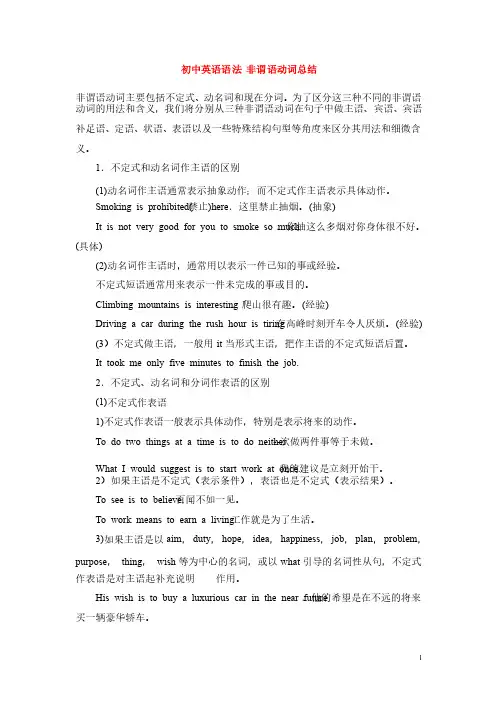
初中英语语法 非谓语动词总结非谓语动词主要包括不定式、非谓语动词主要包括不定式、动名词和现在分词。
动名词和现在分词。
为了区分这三种不同的非谓语动词的用法和含义,动词的用法和含义,我们将分别从三种非谓语动词在句子中做主语、我们将分别从三种非谓语动词在句子中做主语、我们将分别从三种非谓语动词在句子中做主语、宾语、宾语、宾语、宾语宾语补足语、补足语、定语、定语、定语、状语、状语、状语、表语以及一些特殊结构句型等角度来区分其用法和细微含表语以及一些特殊结构句型等角度来区分其用法和细微含义。
义。
1.不定式和动名词作主语的区别.不定式和动名词作主语的区别(1)动名词作主语通常表示抽象动作;而不定式作主语表示具体动作。
Smoking is prohibited(禁止禁止)here .这里禁止抽烟。
(抽象) It is not very good for you to smoke so much .你抽这么多烟对你身体很不好。
(具体) (2)动名词作主语时,通常用以表示一件已知的事或经验。
不定式短语通常用来表示一件未完成的事或目的。
Climbing mountains is interesting .爬山很有趣。
(经验) Driving a car during the rush hour is tiring .在高峰时刻开车令人厌烦。
(经验) (3)不定式做主语,一般用it 当形式主语,把作主语的不定式短语后置。
It took me only five minutes to finish the job. 2.不定式、动名词和分词作表语的区别(1)不定式作表语不定式作表语1)不定式作表语一般表示具体动作,特别是表示将来的动作。
To do two things at a time is to do neither .--次做两件事等于未做。
次做两件事等于未做。
What I would suggest is to start work at once.我的建议是立刻开始干。


初中非谓语动词全总结一. 非谓语动词的含义非谓语动词首先是一种动词形式,其次是这种动词形式不能做谓语,综合这两点,我们将其叫做非谓语动词。
二. 非谓语动词的形式非谓语动词包含四种形式,即不定式、动名词、现在分词和过去分词。
具体形式如下:1. 不定式:to do(表示主动,并且一般表示将来)例如:The teacher told us to do morning exercises .老师让我们做早操。
2. 动名词:doing (表示主动)例如:Travelling in space by ordinary people will be common in the future.在未来,普通人在太空旅行将会是普遍的事情。
3. 现在分词:doing (表示主动和进行)例如:He sat there,reading a newspaper.他坐在那里,读着一张报纸。
4. 过去分词:done及物动词的过去分词表示被动或完成;不及物动词的过去分词表示主动或完成。
polluted river 被污染的河流(及物动词pollute和river之间是被动关系,即“河流被污染”)fallen leaves 落叶(不及物动词fall和leaves之间是主动关系,即“叶子落下来”)注意:非谓语动词本身不能表示现在和过去。
非谓语动词表示进行和将来是相对于谓语动作来说的:和谓语动作同时发生表示进行;发生在谓语动作之后表示将来三. 非谓语动词的作用非谓语动词除去不能做谓语之外,其它所有成分都可以做。
具体如下。
1. 不定式:做主语、宾语、表语、定语、状语和补语。
To learn a foreign language is difficult .(作主语)学会一门外语是很难的。
It’s easy to see their aunt.(作真正主语,it做形式主语)很容易见到他们的姑姑。
Tom wanted to have a cup of beer.(作宾语)汤姆想要喝杯啤酒。

初中英语:“非谓语动词”知识点全总结成才路上特级教师与奥数国家一级教练联手执教。
01非谓语动词的概念在句子中充当除谓语以外的句子成分的动词形式叫作非谓语动词。
02非谓语动词的使用条件一个句子中,已经存在一个主句(谓语动词),又没有连词的情况下,若还有其他动词出现,该动词则充当了非谓语动词。
如:He teaches us to dance on weekends.(teaches主语后,作谓语词;to dance不定式作宾补)03非谓语动词的形式非谓语动词包含四种形式,即不定式、动名词、现在分词和过去分词。
具体形式如下:1. 不定式:to do(表示主动,并且一般表示将来)例如:The teacher told us to do morning exercises .老师让我们做早操。
2. 动名词:doing (表示主动)例如:Travelling in space by ordinary people will be common in the future.在未来,普通人在太空旅行将会是普遍的事情。
3. 现在分词:doing (表示主动和进行)例如:He sat there,reading a newspaper.他坐在那里,读着一张报纸。
4. 过去分词:done及物动词的过去分词表示被动或完成;不及物动词的过去分词表示主动或完成。
polluted river 被污染的河流(及物动词pollute和river之间是被动关系,即“河流被污染”)fallen leaves 落叶(不及物动词fall和leaves之间是主动关系,即“叶子落下来”)注意:非谓语动词本身不能表示现在和过去。
非谓语动词表示进行和将来是相对于谓语动作来说的:和谓语动作同时发生表示进行;发生在谓语动作之后表示将来04非谓语动词的作用非谓语动词除去不能做谓语之外,其它所有成分都可以做。
具体如下。
动词不定式一、特点:1. 没有人称和数的变化2. 可以有自己的宾语和状语3. 有时态和语态的变化(被动语态形式为to be+动词的过去分词)二、句法作用:做主语、宾语、表语、定语、状语和补语。
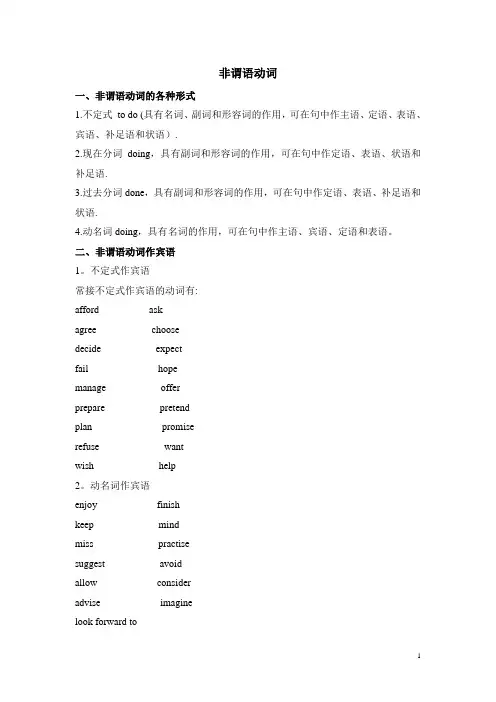
非谓语动词一、非谓语动词的各种形式1.不定式to do (具有名词、副词和形容词的作用,可在句中作主语、定语、表语、宾语、补足语和状语).2.现在分词doing,具有副词和形容词的作用,可在句中作定语、表语、状语和补足语.3.过去分词done,具有副词和形容词的作用,可在句中作定语、表语、补足语和状语.4.动名词doing,具有名词的作用,可在句中作主语、宾语、定语和表语。
二、非谓语动词作宾语1。
不定式作宾语常接不定式作宾语的动词有:afford askagree choosedecide expectfail hopemanage offerprepare pretendplan promiserefuse wantwish help2。
动名词作宾语enjoy finishkeep mindmiss practisesuggest avoidallow consideradvise imaginelook forward to3.不定式与动名词作宾语的区别1)remember doing sthremember to do sthI remembered____the lights when I left the room.(to turn off,turning off)Remember ____the lights when you leave the room。
(to turn off,turning off)2)forget doing sthforget to do sthI have forgotten ____the flowers.(to water,watering)I have forgotten ____my homework.(to do ;doing)3)try doing sthtry to do sthLet’s try____at the back door.(knocking ;to knock)We’ll try ___ our teaching methods.(to improv;improving)4)go on doing sthgo on to do sthGet the children to go on ____stories one by one。
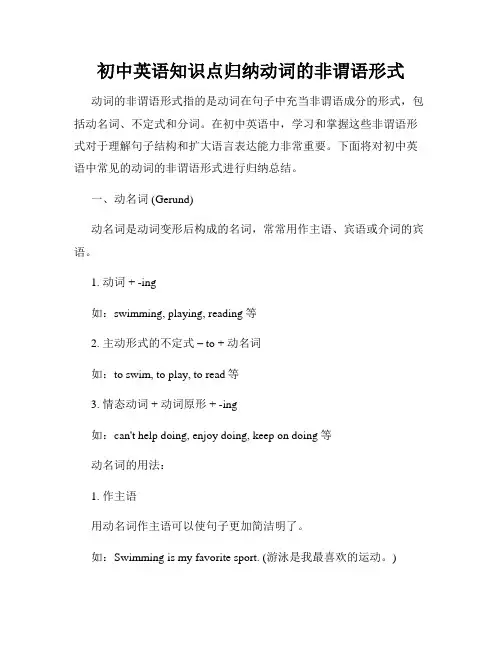
初中英语知识点归纳动词的非谓语形式动词的非谓语形式指的是动词在句子中充当非谓语成分的形式,包括动名词、不定式和分词。
在初中英语中,学习和掌握这些非谓语形式对于理解句子结构和扩大语言表达能力非常重要。
下面将对初中英语中常见的动词的非谓语形式进行归纳总结。
一、动名词 (Gerund)动名词是动词变形后构成的名词,常常用作主语、宾语或介词的宾语。
1. 动词 + -ing如:swimming, playing, reading等2. 主动形式的不定式– to + 动名词如:to swim, to play, to read等3. 情态动词 + 动词原形 + -ing如:can't help doing, enjoy doing, keep on doing等动名词的用法:1. 作主语用动名词作主语可以使句子更加简洁明了。
如:Swimming is my favorite sport. (游泳是我最喜欢的运动。
)2. 作宾语一些动词后常接动名词作宾语,如:enjoy, finish, quit, suggest等。
如:I enjoy reading books. (我喜欢读书。
)3. 作介词的宾语一些介词后常接动名词作宾语,如:at, for, in, on等。
如:She is good at singing. (她擅长唱歌。
)二、不定式 (Infinitive)不定式是动词的一种形式,常常用作动词、形容词或副词的补语。
1. 动词原形 (to + 动词原形)如:to swim, to play, to read等2. 情态动词 + 动词原形如:can, may, must等不定式的用法:1. 作主语用不定式作主语可以使句子更加简洁明了。
如:To learn English well is my goal. (学好英语是我的目标。
)2. 作宾语一些动词后常接不定式作宾语,如:want, plan, hope等。
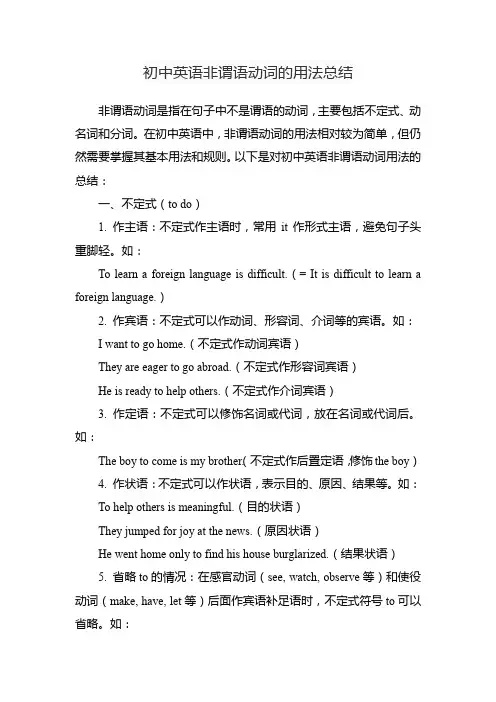
初中英语非谓语动词的用法总结非谓语动词是指在句子中不是谓语的动词,主要包括不定式、动名词和分词。
在初中英语中,非谓语动词的用法相对较为简单,但仍然需要掌握其基本用法和规则。
以下是对初中英语非谓语动词用法的总结:一、不定式(to do)1. 作主语:不定式作主语时,常用it作形式主语,避免句子头重脚轻。
如:To learn a foreign language is difficult.(= It is difficult to learn a foreign language.)2. 作宾语:不定式可以作动词、形容词、介词等的宾语。
如:I want to go home.(不定式作动词宾语)They are eager to go abroad.(不定式作形容词宾语)He is ready to help others.(不定式作介词宾语)3. 作定语:不定式可以修饰名词或代词,放在名词或代词后。
如:The boy to come is my brother.(不定式作后置定语,修饰the boy)4. 作状语:不定式可以作状语,表示目的、原因、结果等。
如:To help others is meaningful.(目的状语)They jumped for joy at the news.(原因状语)He went home only to find his house burglarized.(结果状语)5. 省略to的情况:在感官动词(see, watch, observe等)和使役动词(make, have, let等)后面作宾语补足语时,不定式符号to可以省略。
如:Let’s have him come to the party.(感官动词+不定式省略to)They had me go there.(使役动词+不定式省略to)二、动名词(doing)1. 作主语:动名词作主语时,可以直接用动名词形式,也可以用“名词+动名词”的形式。
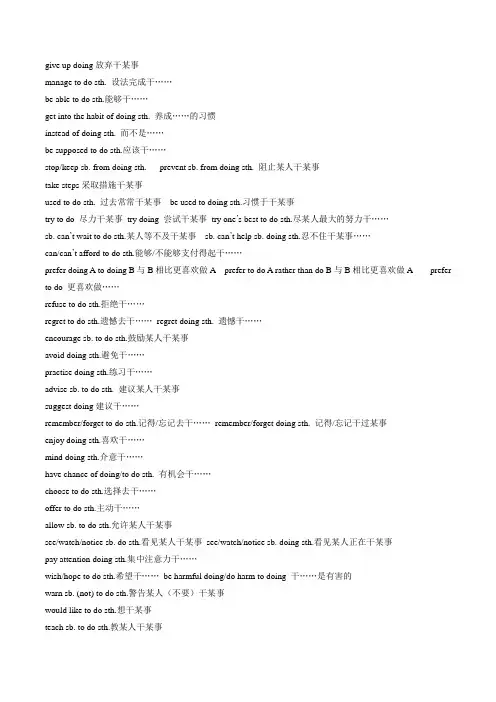
give up doing放弃干某事manage to do sth. 设法完成干……be able to do sth.能够干……get into the habit of doing sth. 养成……的习惯instead of doing sth. 而不是……be supposed to do sth.应该干……stop/keep sb. from doing sth. prevent sb. from doing sth. 阻止某人干某事take steps采取措施干某事used to do sth. 过去常常干某事be used to doing sth.习惯于干某事try to do 尽力干某事try doing 尝试干某事try one’s best to do sth.尽某人最大的努力干……sb. can’t wait to do sth.某人等不及干某事sb. can’t help sb. doing sth.忍不住干某事……can/can’t afford to do sth.能够/不能够支付得起干……prefer doing A to doing B与B相比更喜欢做A prefer to do A rather than do B与B相比更喜欢做A prefer to do 更喜欢做……refuse to do sth.拒绝干……regret to do sth.遗憾去干……regret doing sth. 遗憾干……encourage sb. to do sth.鼓励某人干某事avoid doing sth.避免干……practise doing sth.练习干……advise sb. to do sth. 建议某人干某事suggest doing建议干……remember/forget to do sth.记得/忘记去干……remember/forget doing sth. 记得/忘记干过某事enjoy doing sth.喜欢干……mind doing sth.介意干……have chance of doing/to do sth. 有机会干……choose to do sth.选择去干……offer to do sth.主动干……allow sb. to do sth.允许某人干某事see/watch/notice sb. do sth.看见某人干某事see/watch/notice sb. doing sth.看见某人正在干某事pay attention doing sth.集中注意力干……wish/hope to do sth.希望干……be harmful doing/do harm to doing 干……是有害的warn sb. (not) to do sth.警告某人(不要)干某事would like to do sth.想干某事teach sb. to do sth.教某人干某事start to do/doing sth.开始干某事be ready to do sth.乐于干某事promise to do sth.承诺干某事look forward to doing sth.盼望干某事enjoy doing sth.喜欢干某事sb. need to do sth.某人需要干某事sth. need doing sth.某物需要被……ask sb. to do sth.要求某人干某事be able to do sth.能够干某事why not do sth.为什么不干……It takes sb. some time/money to do sth.干某事花费某人多长时间decide to to do sth.决定干某事notice sb. do sth. 看见某人干某事notice sb. doing sth.注意到某人正在干……finish doing sth.完成干……What/How about doing sth.干……是怎么样的be busy doing忙于干……be good at doing sth.擅于干……use sth. to do sth.用某物干某事sb. spend some time doing sth.某人花费时间干某事be afraid to do sth./of doing sth.害怕干某事feel like doing sth.想要干某事stop to do sth.停止去干某事stop doing sth.停止干某事It is adj. (for sb.)to do sth.对某人来说干……是怎么样的imagine doing sth.想象干……have trouble doing 在干……有困难make/let/have sb. do sth.让某人干某事tell sb. to do sth. 告诉某人干某事have fun doing sth.干某事很快乐介词后加动词ing 特殊疑问词后加to do。
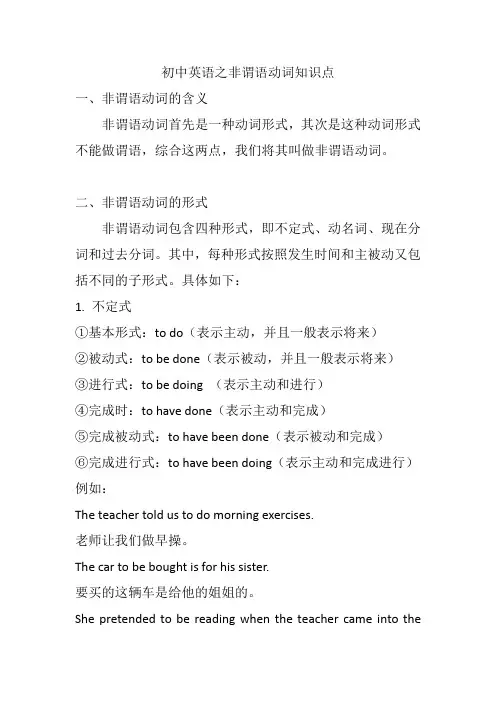
初中英语之非谓语动词知识点一、非谓语动词的含义非谓语动词首先是一种动词形式,其次是这种动词形式不能做谓语,综合这两点,我们将其叫做非谓语动词。
二、非谓语动词的形式非谓语动词包含四种形式,即不定式、动名词、现在分词和过去分词。
其中,每种形式按照发生时间和主被动又包括不同的子形式。
具体如下:1. 不定式①基本形式:to do(表示主动,并且一般表示将来)②被动式:to be done(表示被动,并且一般表示将来)③进行式:to be doing (表示主动和进行)④完成时:to have done(表示主动和完成)⑤完成被动式:to have been done(表示被动和完成)⑥完成进行式:to have been doing(表示主动和完成进行)例如:The teacher told us to do morning exercises.老师让我们做早操。
The car to be bought is for his sister.要买的这辆车是给他的姐姐的。
She pretended to be reading when the teacher came into theclassroom.老师进来时,她假装正在读书。
The thief is said to have escaped.据说小偷已经逃跑了。
The thief is said to have been arrested.据说小偷已经被抓住了。
She is said to have been working in the factory over the last 20 years.据说在过去的20年里,她一直在这家工厂工作。
2. 动名词①基本形式:doing(表示主动)②被动式:being done(表示被动)③完成式:having done(表示主动和完成)④完成被动式:having been done(表示被动和完成)例如:Travelling in space by ordinary people will be common in the future.在未来,普通人在太空旅行将会是普遍的事情。
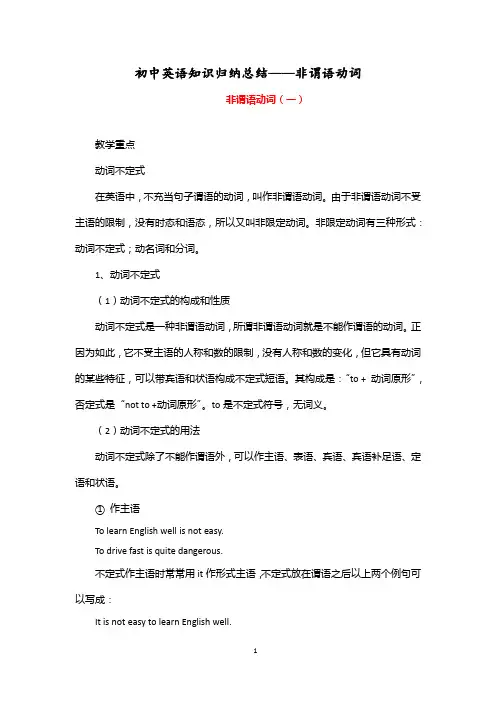
初中英语知识归纳总结——非谓语动词非谓语动词(一)教学重点动词不定式在英语中,不充当句子谓语的动词,叫作非谓语动词。
由于非谓语动词不受主语的限制,没有时态和语态,所以又叫非限定动词。
非限定动词有三种形式:动词不定式;动名词和分词。
1、动词不定式(1)动词不定式的构成和性质动词不定式是一种非谓语动词,所谓非谓语动词就是不能作谓语的动词。
正因为如此,它不受主语的人称和数的限制,没有人称和数的变化,但它具有动词的某些特征,可以带宾语和状语构成不定式短语。
其构成是:“to + 动词原形”,否定式是“not to +动词原形”。
to是不定式符号,无词义。
(2)动词不定式的用法动词不定式除了不能作谓语外,可以作主语、表语、宾语、宾语补足语、定语和状语。
①作主语To learn English well is not easy.To drive fast is quite dangerous.不定式作主语时常常用it作形式主语,不定式放在谓语之后以上两个例句可以写成:It is not easy to learn English well.It is quite dangerous to drive fast.这种用法可以归纳成这样一个句型:It is (not) + 形容词+ (for sb.) to do sth.It is very expensive for me to buy a car.It is very difficult for a child to do that job.有些形容词之后跟of + 名词(代词宾语)+不定式。
如:It is very kind of you to say so.It is very good of you to come.②作表语。
如:My job is to teach English.The first thing is to ring him up.③作宾语。
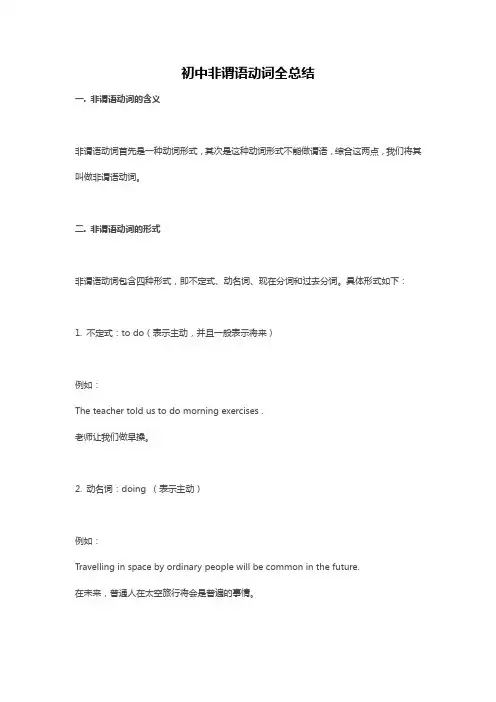
初中非谓语动词全总结一. 非谓语动词的含义非谓语动词首先是一种动词形式,其次是这种动词形式不能做谓语,综合这两点,我们将其叫做非谓语动词。
二. 非谓语动词的形式非谓语动词包含四种形式,即不定式、动名词、现在分词和过去分词。
具体形式如下:1. 不定式:to do(表示主动,并且一般表示将来)例如:The teacher told us to do morning exercises .老师让我们做早操。
2. 动名词:doing (表示主动)例如:Travelling in space by ordinary people will be common in the future.在未来,普通人在太空旅行将会是普遍的事情。
3. 现在分词:doing (表示主动和进行)例如:He sat there,reading a newspaper.他坐在那里,读着一张报纸。
4. 过去分词:done及物动词的过去分词表示被动或完成;不及物动词的过去分词表示主动或完成。
polluted river 被污染的河流(及物动词pollute和river之间是被动关系,即“河流被污染”)fallen leaves 落叶(不及物动词fall和leaves之间是主动关系,即“叶子落下来”)注意:非谓语动词本身不能表示现在和过去。
非谓语动词表示进行和将来是相对于谓语动作来说的:和谓语动作同时发生表示进行;发生在谓语动作之后表示将来三. 非谓语动词的作用非谓语动词除去不能做谓语之外,其它所有成分都可以做。
具体如下。
1. 不定式:做主语、宾语、表语、定语、状语和补语。
To learn a foreign language is difficult .(作主语)学会一门外语是很难的。
It’s easy to see their aunt.(作真正主语,it做形式主语)很容易见到他们的姑姑。
Tom wanted to have a cup of beer.(作宾语)汤姆想要喝杯啤酒。
初中非谓语动词用法总结
非谓语动词是指不具有人称和数的动词形式,主要包括不定式、动名词和现在分词三种形式。
它们在句子中可以作主语、宾语、定语、状语等成分。
下面是初中非谓语动词用法的总结:
1. 不定式
不定式一般由“to + 动词原形”构成,可以表示目的、原因、结
果等。
- 作主语:To learn English well is important.
- 作宾语:I want to go shopping.
- 作定语:I have a book to read.
- 作状语:He came to help us.
2. 动名词
动名词是动词的-ing形式,可作主语、宾语、定语、状语等。
- 作主语:Swimming is good for health.
- 作宾语:She enjoys dancing.
- 作定语:He is a writing teacher.
- 作状语:She left, crying in disappointment.
3. 现在分词
现在分词一般由动词的-ing形式构成,可以作定语、状语等。
- 作定语:The running water is clear.
- 作状语:He walked out of the room, smiling.
以上是初中非谓语动词用法的简单总结,它们在句子中的具体用法多种多样,需要根据上下文和语境进行理解和运用。
通过多做练,我们可以更好地掌握非谓语动词的用法。
请注意,以上内容仅供参考,具体表达需要根据实际情况进行调整和扩展。
最全的非谓语动词知识点总结非谓语动词是指动词的非动词形式,分为动词不定式、动名词和现在分词、过去分词。
下面是非谓语动词的最全知识点总结:一、动词不定式(Infinitive)1.动词不定式的形式:- 常规形式:to+动词原形(to do)- 被动形式:to be done- 完成形式:to have done2.动词不定式的用法:- 作主语:To read books is my hobby.- 作宾语:I want to go home.- 作定语:Can you give me something to eat?- 作状语:I study hard to pass the exam.3.动词不定式与一些动词搭配:- 动词make, let, have, help后接动词原形作宾语:She made me clean the room.- 动词比如tell, ask, advise, want, expect后可接动词不定式作宾语补足语:She told me to go there.二、动名词(Gerund)1.动名词的形式:- 动词原形+ing(doing)2.动名词的用法:- 作主语:Swimming is good for health.- 作宾语:I enjoy reading books.- 作表语:His job is teaching English.- 作定语:The running water sounds relaxing.- 作状语:I walked home, singing songs.3.动名词与一些动词搭配:- 动词stop, finish, keep, mind后接动名词作宾语:He finished reading the book.- 动词enjoy, dislike, mind后接动名词作宾语:I enjoy swimming.三、现在分词(Present Participle)1.现在分词的形式:- 原形+ing(doing)2.现在分词的用法:- 作定语:The crying baby needs attention.- 作状语:He left the party, feeling disappointed.3.现在分词与一些动词搭配:- 动词keep, catch, find后接现在分词作宾补:I caught him stealing my money.- 动词see, hear, notice后接现在分词作宾补:I saw him walking in the park.四、过去分词(Past Participle)1.过去分词的形式:- 动词的过去分词形式(done)2.过去分词的用法:- 用于完成时态:I have finished my homework.- 用于被动语态:The book was written by him.3.过去分词与一些动词搭配:- 动词have, has, had, get, be等后接过去分词构成完成时态:He has eaten breakfast.- 动词make, let, have, get后接过去分词构成被动语态:She was made to clean the room.。
对初中英语非谓语动词的全面总结非谓语动词在英语语法中扮演着重要的角色。
它们包括带to不定式、省to不定式、动词ing形式和动词的过去分词。
在句子中,动词的形式取决于句子的含义和前一个动词的制约。
为了帮助学生更好地理解和记忆非谓语动词,我们将相同规律的动词放在一起进行总结。
一、关于动词不定式(to+动词)一)动词不定式在句中做前一个动词的宾语。
许多动词可以直接接动词不定式作宾语,学生应该对这些动词敏感。
以下是一些常见的及物动词:1.want to do 想要2.would like to do 想要做3.hope to do 希望做4.wish to do 希望做5.decide to do 决定做6.plan to do 计划做7.refuse to do 拒绝做8.fail to do 做某事失败9.manage to do 设法做10.agree to do 同意做11.learn to do 学会做12.happen to do 偶然发生13.need to do 需要做14.pretend to do 假装做15.offer to do 提供做16.promise to do 允许做17.attempt to do 企图做18.be sure to do 确定做19.seem to do 似乎要发生20.XXX do 期待做21.try\do one’s best to do 尽力做22.can’t wait to do 迫不及待做23.can’t afford to do 负担不起做二)动词不定式在句中作宾语补足语。
一些动词可以接动词不定式作宾语补足语。
以下是一些常见的动词结构:1.want sb to do 想让某人做2.would like sb to do 想让某人做3.wish sb to do 希望某人做(不能用hope)4.agree sb to do 同意某人做5.ask sb (not) to do 让某人(不)做6.tell sb to do 告诉某人做7.allow sb to do 允许某人做8.advise sb to do 建议某人做2、a desire to do XXX想要做某事的愿望3、XXX做某事的理由4、a way to do sth做某事的方法5、a need to do sth做某事的需要6、a plan to do sth做某事的计划7、a XXX做某事的决定Encouraging someone to do something is a great way to XXX to do something can also push them to do their best。
初二英语非谓语动词知识点总结及解析一、非谓语动词1.It is wise ______Linda to make up her mind _______to play an instrument.A. for; learningB. for; to learnC. of; learningD. of; to learn【答案】 D【解析】【分析】句意:琳达下决心学弹乐器是明智的。
由句子结构可知,不定式作真正的主语,放在句末,用it作形式主语。
要用固定句型:It's + adj +for/of sb to do sth.前面的形容词来描述不定式时,要用介词for;形容词说明人时,要用介词of。
这里的形容词wise是形容人的性格特征的,要用It's + adj +of sb to do sth.,故选D。
【点评】考查固定句型It's + adj +for/of sb to do sth.的用法区别。
根据形容词的属性,选择正确的介词。
2.We advise parents _____ their children at home alone in order to keep them away from danger.A. not leaveB. not to leaveC. leaveD. to leave【答案】 B【解析】【分析】句意:为了使孩子远离危险,我们建议父母不要单独把孩子留在家里。
advise sb to do sth建议某人做某事,动词不定式的否定形式就是在to前面加not故advise sb not to do sth建议某人不要做某事。
结合句意,故选B3.My mother doesn't allow me _______outside too late on school nights.A. to stayB. stayC. staying【答案】 A【解析】【分析】句意:在上学的日子里,我妈妈不允许我在外面待得太晚。
非谓语动词总结非谓语动词:即,在句子中除了充当谓语以外成分的词。
它可以分为动名词,动词不定式,分词。
初中着重讲前两种。
一.后面可跟动词的ing形式的情况1.动词:finish doing sth.完成做某事;enjoy doing sth. 喜欢做某事;practice doing sth. 练习做某事;imagine doing,想象做某事;avoid doing sth.避免做某事;consider doing sth.考虑做某事;suggest doing sth.建议做某事;mind doing sth.介意做某事;keep doing sth.持续做某事2.固定短语:feel like doing sth.喜欢做某事;be busy doing sth.忙于做某事;be worth doing 值得做某事;spend time (in) doing sth.花费时间(金钱)做某事;have difficult/trouble in doing sth做某事有困难;have fun doing.做某事高兴3.介词后(on, in, of, about, at, with, without, for, from, up, by等)如:be good at doing sth.;thank you for doing sth.;give up doing sth.;stop sb. from doing sth.;do well in doing sth.;be afraid of doing sth.;be interested in doing sth.;be proud of;instead of;be fond of4.to作介词的情况look forward to doing sth期望做某事;prefer doing sth. to doing sth与…相比较更喜欢…;pay attention to doing 注意做某事;be/get used to doing sth.习惯于做某事;make a contribution to为…做贡献二.后面可跟动词的不定式形式的情况1.动词:agree to do同意去做;afford to do买得起;decide to do 决定去做某事;hope to do希望去做;wish to do希望去做;fail to do 做某事失败去;plan to do打算去做;pretend to do假装去做;refuse to do拒绝去做;would like to do想要去做;want to do想要去做某事;learn to do 学做;prefer to do sth. 喜欢(爱)做某事;sb. seem to do sth好像做某事;want/would like to do sth. 想做……;used to do sth. 过去常做某事2.句型.allow sb. to do sth. 允许某人去做某事asked sb. (not) to do sth. 叫某人做事某事(叫某人不要去做某事)tell sb. (not) to do sth. 叫某人去(不要)做某事follow sb. to do sth. 跟随某人去做某事get sb. to do sth. 让某人做某事warn sb. (not) to do sth. 警告某人做某事(或不要做某事)be amazed to do sth. 对做某事感到惊讶be afraid to do sth. 害怕做某事be excited to do sth. 对做……感到兴奋be frightened to do sth. 害怕去做某事be glad/happy to do sth. 高兴去做某事be/get ready to do sth.准备做某事be sorry to do sth. 对做某事感到抱歉be surprised to do sth. 对做某事感到惊奇can’t wait to do sth. 迫不急待地去做某事get/have a chance to do sth. 得到一个做某事的机会It’s + a dj.+(for sb.) to do sth. 做某事(对某人来说)怎么样It’s +adj. +(of sb.) to do sth.It takes sb. some time/money to do sth. 花费某人多长时间做某事It’s best for sb. to do sth. 对某人来说做某事是最好的It’s time for sb. to do sth. 是某人做某事的时候了too…(for sb.) to …太…以致不能… =not… enough to do =so…that prefer to do sth. rather than do sth. 宁愿……而不愿……(常考)something to eat/drink 一些吃/喝的东西(动词不定式放在something等后)Sth. is hard/difficult/easy to do 做好某事很难/容易take turns to do sth. 轮流做……There is no time (for sb. ) to do sth. 对(某人来说)没时间做某事了There is no need (for sb.) to do sth. 对某人来说没必要做某事try/do one’s best to do sth. 尽力去做某事3.动词不定式与疑问代词和疑问副词的连用。
初中非谓语动词最全总结非谓语动词包括动名词、动词不定式和分词。
在初中教育中,我们主要研究前两种形式。
一、动名词动名词除了可以作为谓语以外,还可以作为其他成分,如宾语、主语、表语、宾语补足语等。
以下是一些常见的动名词用法:1.动词 + 动名词:XXX.(完成做某事)、XXX.(喜欢做某事)、XXX.(练做某事)、XXX.(想象做某事)、XXX.(避免做某事)、XXX.(考虑做某事)、XXX.(建议做某事)、XXX.(介意做某事)、keep XXX.(持续做某事)。
2.固定短语:XXX.(喜欢做某事)、XXX.(忙于做某事)、be XXX.(值得做某事)、spend time (in) XXX.(花费时间(金钱)做某事)、XXX.(做某事有困难)、have fun XXX.(做某事高兴)。
3.介词后(on。
in。
of。
about。
at。
with。
without。
for。
from。
up。
by等):be good at doing sth.(擅长做某事)、thank you for doing sth.(感谢做某事)、give up XXX.(放弃做某事)、XXX.(阻止某人做某事)、do well in doing sth.(做某事做得好)、XXX.(害怕做某事)、be XXX.(对做某事感兴趣)、be proud of(以…为自豪)、instead of(代替)、be fond of(喜爱)。
4.to作介词:look forward to doing sth.(期望做某事)、XXX.(与…相比较更喜欢…)、pay n to doing sth.(注意做某事)、be/get used to doing sth.(惯于做某事)、XXX(为…做贡献)。
二、动词不定式动词不定式通常作为动词的宾语、宾语补足语、主语、表语、定语等。
以下是一些常见的动词不定式用法:1.动词 + 不定式:decide to do sth.(决定做某事)、want to do sth.(想做某事)、XXX.(希望做某事)、try to do sth.(尝试做某事)、fail to do sth.(未能做某事)、XXX.(拒绝做某事)、promise to do sth.(承诺做某事)、manage to do sth.(设法做某事)。